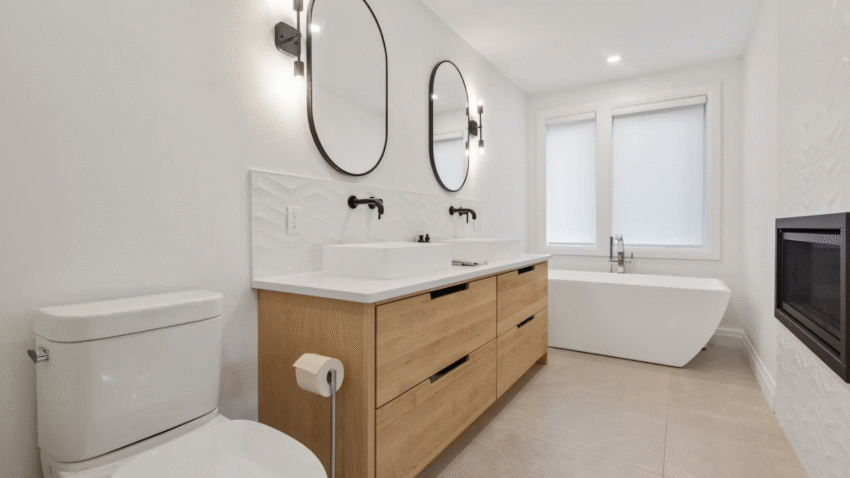Introduction
Worried about water damage seeping through your bathroom floor? This guide will show you how to waterproof a bathroom floor the right way—step by step. From tile cracks to gaps in the corners, bathrooms face constant exposure to moisture that can slowly ruin your subfloor and invite mold. A solid waterproofing job helps protect your home and keeps your bathroom dry and safe for years.
Why Waterproofing Your Bathroom Floor Matters
Bathrooms are high-risk areas for water leaks. Whether it’s from a dripping pipe, a splashy shower, or condensation, moisture can easily sneak through flooring and wreak havoc below. Left unchecked, water penetration can cause mold growth, wood rot, peeling tiles, and even structural damage.
Waterproofing your bathroom floor creates a moisture barrier that keeps water where it belongs—on the surface. It also boosts the durability of tiles, grout, and subflooring materials, making future maintenance easier and less expensive. Whether you’re building new or updating an old bathroom, waterproofing is essential for long-term protection.
Step-by-Step Guide to Waterproofing a Bathroom Floor
1. Gather the Right Tools and Materials
Before you begin, stock up on the following supplies:
- Waterproofing membrane (liquid or sheet type)
- Waterproof primer
- Paint roller and brushes
- Utility knife
- Silicone or polyurethane caulk
- Waterproof tape or joint sealing tape
- Grout sealer (for tiled floors)
- Drop cloths and painter’s tape
- Safety gear (gloves, goggles, ventilation mask)
Tip: Choose products specifically designed for bathroom or wet-area use.
2. Prepare and Clean the Floor
Start with a clean, dry, and smooth surface:
- Remove old flooring or debris if doing a remodel.
- Vacuum dust and wipe down the surface with a damp rag.
- Repair any cracks or holes with patching compound.
- Let the floor dry completely before moving to the next step.
Warning: Never apply waterproofing products to a damp floor—it will prevent proper adhesion.
3. Seal Floor Joints and Edges
Water often leaks through corners and edges first:
- Apply waterproof caulk along all wall-to-floor joints.
- Pay close attention to gaps near tubs, toilets, and shower bases.
- Let the caulk cure for 24 hours, or as directed by the product instructions.
- Apply waterproof tape or mesh to corners and seams for added protection.
4. Prime the Floor
Priming helps the waterproof membrane stick better:
- Use a waterproof primer designed for your membrane type (check product label).
- Apply it evenly across the entire floor using a paint roller.
- Let it dry completely—usually about 1–2 hours depending on temperature and ventilation.
Tip: Some primers change color slightly when dry, so watch for that signal.
5. Apply Waterproof Membrane
This is the key step in waterproofing your bathroom floor:
For Liquid Membrane:
- Stir the liquid membrane thoroughly before applying.
- Use a brush to cut into edges and corners, then roll the rest on with a roller.
- Apply in two coats—one vertically and one horizontally—for full coverage.
- Allow each coat to dry per manufacturer instructions (typically 12–24 hours).
For Sheet Membrane:
- Cut sheets to size, leaving overlap for seams.
- Apply adhesive or thin-set mortar as directed.
- Press the sheets firmly into place, removing air bubbles.
- Overlap seams by 2–3 inches and tape them for extra security.
Warning: Always wear gloves and ventilate the room while applying membranes.
6. Seal Around Fixtures
Use caulk to seal around the toilet base, sink pedestal, and shower enclosure:
- Silicone or polyurethane sealant provides flexible, long-lasting protection.
- Let it cure completely before exposing to moisture.
- Avoid using the bathroom during this curing period.
7. Add a Grout Sealer (If Tiled)
If you have a tile floor:
- Let the tiles and grout dry fully after installation.
- Apply a grout sealer using a sponge or brush.
- Wipe off excess sealer and let it cure according to product instructions.
Tip: Reseal grout every 1–2 years to maintain waterproof protection.
Common Mistakes to Avoid
Mistake 1: Skipping the primer
Solution: Always prime the surface. Skipping this step weakens the waterproofing bond and causes peeling later.
Mistake 2: Rushing the drying time
Solution: Allow full drying and curing between coats. Using the bathroom too soon can damage the membrane.
Mistake 3: Not sealing edges and corners properly
Solution: Use waterproof caulk and tape at all joins. These are the first places water will try to enter.
Mistake 4: Using general-purpose materials
Solution: Use waterproofing products designed specifically for wet areas like bathrooms.
Mistake 5: Applying membrane to a dirty or damp floor
Solution: Clean and fully dry the surface before application to ensure proper adhesion.
Extra Tips & Bathroom Hacks
- Consider using a shower tray liner beneath tiled floors for extra leak protection.
- Install a slight slope in the floor toward the drain to prevent water pooling.
- Check out our guide on how to seal around a bathtub to ensure every edge is watertight.
- Use waterproofing paint on bathroom walls for bonus protection in humid areas.
Conclusion
Waterproofing your bathroom floor is one of the best ways to protect your home from hidden water damage and mold. With the right tools and materials, you can create a durable barrier that keeps moisture out and your subfloor safe. Follow each step carefully—from prepping and priming to sealing edges and applying membrane—and your bathroom will stay dry and damage-free for years to come.
🛠️ Bookmark this guide and come back any time you need to refresh your bathroom’s waterproofing like a pro.
